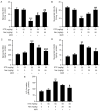Naringenin alleviates myocardial ischemia reperfusion injury by enhancing the myocardial miR-126-PI3K/AKT axis in streptozotocin-induced diabetic rats
- PMID: 34093766
- PMCID: PMC8170646
- DOI: 10.3892/etm.2021.10242
Naringenin alleviates myocardial ischemia reperfusion injury by enhancing the myocardial miR-126-PI3K/AKT axis in streptozotocin-induced diabetic rats
Abstract
Ischemic heart disease (IHD) is a leading cause of death in patients with type 1 diabetes. The key to treating IHD is to restore blood supply to the ischemic myocardium, which inevitably causes myocardial ischemia reperfusion (MI/R) injury. Although naringenin (Nar) prevents MI/R injury, the role of Nar in diabetic MI/R (D-MI/R) injury remains to be elucidated. The PI3K/AKT signaling pathway and microRNA (miR)-126 have previously been shown to serve anti-MI/R injury roles. The present study aimed to investigate the protection of Nar against D-MI/R injury and the role of the miR-126-PI3K/AKT axis. Diabetic rats were treated distilled water or Nar (25 or 50 mg/kg, orally) for 30 days and then exposed to MI/R. The present results revealed that Nar alleviated MI/R injury in streptozotocin (STZ)-induced diabetic rats, as shown below: the reduction myocardial enzymes levels was measured using spectrophotometry, the increase of cardiac viability was detected by MTT assay, the inhibition of myocardial oxidative stress was measured using spectrophotometry and the enhancement of cardiac function were recorded using a hemodynamic monitoring system. Furthermore, Nar upregulated the myocardial miR-126-PI3K/AKT axis in D-MI/R rats. These results indicated that Nar alleviated MI/R injury through upregulating the myocardial miR-126-PI3K/AKT axis in STZ-induced diabetic rats. The current findings revealed that Nar, as an effective agent against D-MI/R injury, may provide an effective approach in the management of diabetic IHD.
Keywords: PI3K/AKT signaling; ischemic heart disease; microRNA-126; myocardial ischemia reperfusion injury; naringenin.
Copyright © 2020, Spandidos Publications.
Conflict of interest statement
The authors declare that they have no competing interests.
Figures






Similar articles
-
Rosmanol Alleviates Myocardial Ischemia-Reperfusion Injury by Enhancing the Myocardial miR-126/VEGF/PI3K/AKT Signaling in STZ-Induced Diabetic Rats.Comb Chem High Throughput Screen. 2024 Aug 26. doi: 10.2174/0113862073285839240808113152. Online ahead of print. Comb Chem High Throughput Screen. 2024. PMID: 39192654
-
Inhibition of miR-181b-5p protects cardiomyocytes against ischemia/reperfusion injury by targeting AKT3 and PI3KR3.J Cell Biochem. 2019 Dec;120(12):19647-19659. doi: 10.1002/jcb.29271. Epub 2019 Jul 11. J Cell Biochem. 2019. PMID: 31297863
-
N-Acetylcysteine and allopurinol up-regulated the Jak/STAT3 and PI3K/Akt pathways via adiponectin and attenuated myocardial postischemic injury in diabetes.Free Radic Biol Med. 2013 Oct;63:291-303. doi: 10.1016/j.freeradbiomed.2013.05.043. Epub 2013 Jun 6. Free Radic Biol Med. 2013. PMID: 23747931
-
Resveratrol increase myocardial Nrf2 expression in type 2 diabetic rats and alleviate myocardial ischemia/reperfusion injury (MIRI).Ann Palliat Med. 2019 Nov;8(5):565-575. doi: 10.21037/apm.2019.11.25. Ann Palliat Med. 2019. PMID: 31865720
-
Protective potential of naringenin and its nanoformulations in redox mechanisms of injury and disease.Heliyon. 2023 Nov 25;9(12):e22820. doi: 10.1016/j.heliyon.2023.e22820. eCollection 2023 Dec. Heliyon. 2023. PMID: 38058425 Free PMC article. Review.
Cited by
-
Effects of Pera Orange Juice and Moro Orange Juice in Healthy Rats: A Metabolomic Approach.Metabolites. 2023 Aug 2;13(8):902. doi: 10.3390/metabo13080902. Metabolites. 2023. PMID: 37623846 Free PMC article.
-
Insight into the Role of the PI3K/Akt Pathway in Ischemic Injury and Post-Infarct Left Ventricular Remodeling in Normal and Diabetic Heart.Cells. 2022 May 5;11(9):1553. doi: 10.3390/cells11091553. Cells. 2022. PMID: 35563860 Free PMC article. Review.
-
Crosstalk between MiRNAs/lncRNAs and PI3K/AKT signaling pathway in diabetes mellitus: Mechanistic and therapeutic perspectives.Noncoding RNA Res. 2024 Jan 14;9(2):486-507. doi: 10.1016/j.ncrna.2024.01.005. eCollection 2024 Jun. Noncoding RNA Res. 2024. PMID: 38511053 Free PMC article. Review.
References
-
- Nordlie MA, Wold LE, Simkhovich BZ, Sesti C, Kloner RA. Molecular aspects of ischemic heart disease: Ischemia/reperfusion-induced genetic changes and potential applications of gene and RNA interference therapy. J Cardiovasc Pharmacol Ther. 2006;11:17–30. doi: 10.1177/107424840601100102. - DOI - PubMed
LinkOut - more resources
Full Text Sources
